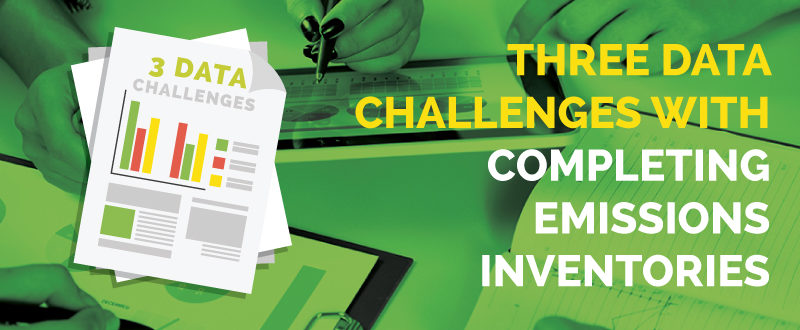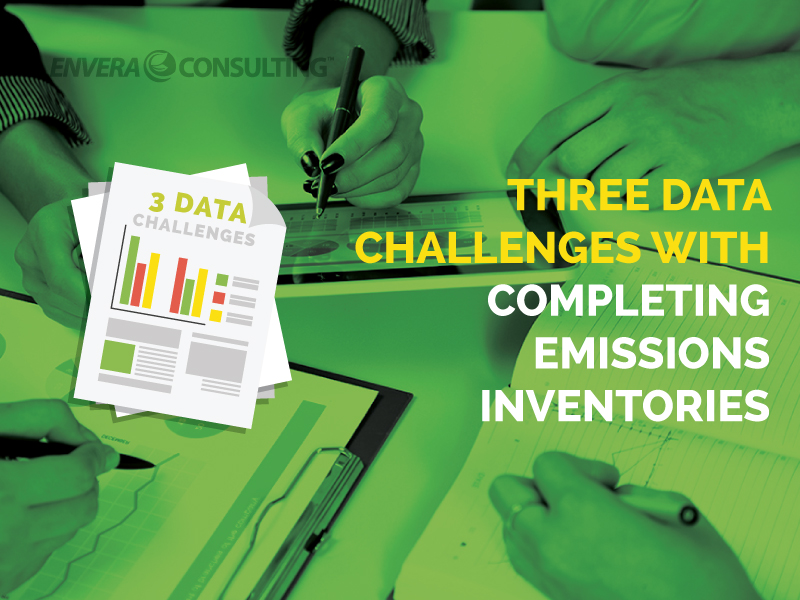

The last two posts have discussed emissions inventories, both a process overview and the formula for calculating equipment emissions. This week, I’m going to discuss three common challenges associated with completing an emissions inventory — which, not coincidentally, are all based on the data needed to complete your upcoming Annual Emissions Report (AER). Every project has its challenges, particularly if it’s the first time you’re undertaking it, so it’s always good to anticipate hitting a few bumps in the road.
Here are the bumps I’ve most often encountered:
1. Having an incomplete data set
More often than not, data will either be missing, in the wrong units, or simply not available at all. You just have to prepare for that. Common reasons data might be missing are:
- Broken equipment
- Failure of the operator to write down the data
- Poor recordkeeping
Sometimes, getting this missing data is merely a matter of reverse engineering — such as converting from metric units. Other times, you may have to take measurements in the field, testing each piece of equipment before crunching the numbers to get the data you need. You’ll also most likely have to improvise by trying to use surrogate data to get any missing data you’re after.
Let’s use the example of calculating emissions from an engine. Typically, the most important piece of data for this type of calculation is the volume of fuel combusted in the engine. However, in practice, the fuel volume is often not tracked as closely as, say, the number of hours the engine operated (because timers are more common that fuel-flow meters). That means that, although you need the fuel volume, you only have the amount of time the engine was operated. Using the known data about operating time, you can make an assumption about the fuel consumption rate to get the fuel volume.
2. Having conflicting data
In any given facility, there are numerous different meters and sensors that can be used to provide the data you need to calculate emissions. And in most cases, the staff tasked with collecting the meter data may not be completely sure about the purpose behind their task, leading them to be less than accurate with their measurements. And, of course, there’s always human error, which is a common source of data conflicts.
Let’s use an example of calculating emissions from a natural gas-fired boiler. In this case, the most important piece of data is the volume of fuel combustion during a given period. This fuel volume will most likely need to be converted to standard conditions, as opposed to actual conditions, which can be affected by factors such as the temperature and pressure of the fuel. To do this, you’ll need three pieces of data: the fuel volume, fuel pressure, and fuel temperature.
The problem here once again is human error. Sometimes, operators don’t even check to make sure the numbers they’re recording make sense, particularly if they’re unsure as to why they’re collecting the data. It’s possible for an operator to take a temperature reading that conflicts or is not entirely accurate. For example, what happens if the operator writes down a pressure of 100 psig (pounds per square inch gauge), when you know that the delivery pressure at your facility is 20 PSIG? In this case, you need to use other pieces of information (such as the fuel pressure from a similar piece of equipment) to get the necessary data.
When dealing with conflicting data, it’s best to remember the objective of the project: What will this information be used for? If you need very accurate data but the data is not available, you may have to resort to another method to get the information you need.
3. Having inaccurate data
Over- or under-estimated data is almost inevitable, because emission sources are dynamic entities that change according to a variety of factors, ranging from production to the weather. For example, the results of an emissions test represent a snapshot of the emissions profile during one period, during which time it’s quite possible the equipment might not have been operating at its normal capacity (due to a load that is either below or above average), which can lead to an under- or over-estimation of emissions. We’ve also seen over-reporting of emissions from process vessels because incorrect calculations were used, such as using calculations for vertical fixed-roof storage tanks when you should be using the calculations for process tanks. (It happens more often than you might think.)
As a rule of thumb, I recommend always conservatively over-estimating emissions (within reason). Although this may mean that you end up paying more on your AER, it’s better than finding out you underreported, which could lead to an even messier compliance situation.
For this reason, I often say that accuracy is dependent on the objective of the project. In general, the more accurate an emissions inventory is, the more resources (time, money, etc.) it requires. You’ll have to weigh the benefits of spending more money on an emissions inventory versus dealing with potential consequences due to inaccuracy.
If you need help making sense of what data is needed to prepare your annual emission report, contact Envera Consulting for help.